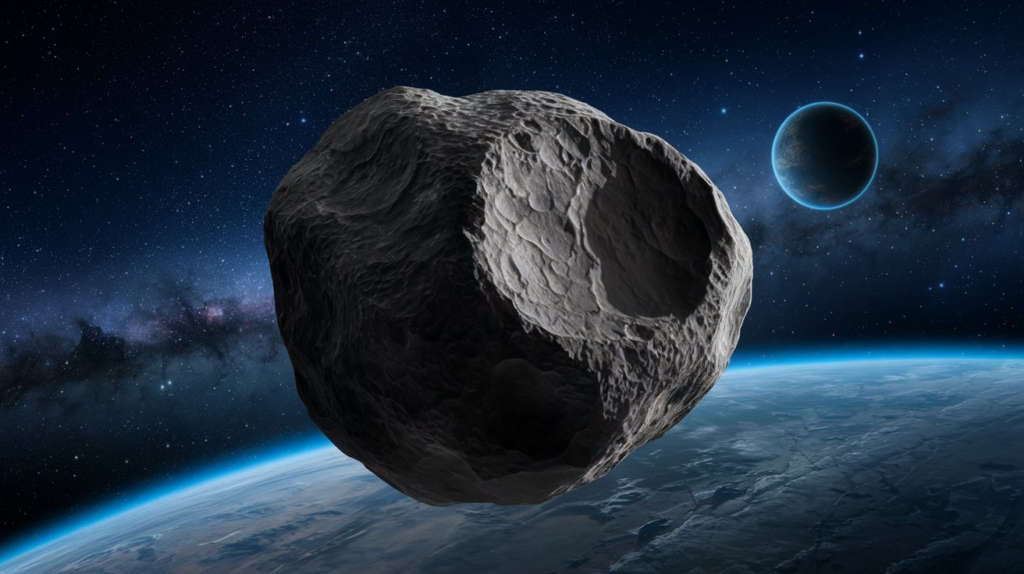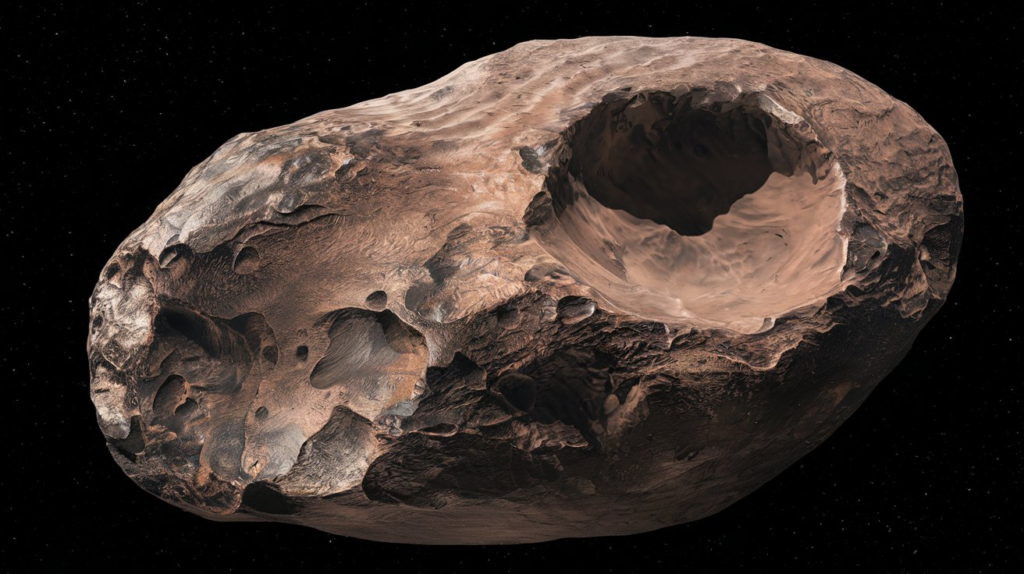
NASA’s Urgent Asteroid Alert: 720-Foot Space Rock on Collision Course with Earth — Are We at Risk Today?
Introduction: A Close Encounter with the Unknown
As we continue to explore the vastness of the universe, it’s impossible to ignore the ever-present mysteries that surround us. The cosmos is full of untold wonders, but it also carries hidden dangers that could change life as we know it. One such potential threat has grabbed headlines today, as NASA issues an urgent alert: a massive asteroid, towering at an incredible 720 feet, is hurtling toward Earth at alarming speeds.
The news sends chills down our spines, evoking memories of blockbuster films like Armageddon or Deep Impact, where humanity races against time to avert disaster. But is today’s encounter with this colossal space rock merely a close call, or are we genuinely in danger?
In this article, we’ll delve into the science behind this celestial visitor, NASA’s warning, and what it means for all of us. We’ll break down the facts step-by-step, dispel myths, and provide you with everything you need to know about asteroids and the latest threat.
1. The Asteroid: What We Know
Asteroids are remnants from the early solar system, and while most quietly orbit the sun between Mars and Jupiter, some stray close to our planet. The one we’re discussing today has been designated as 2024 AG18, and it’s no ordinary space rock. Standing at approximately 720 feet, it’s roughly the size of a 60-story building — a colossal chunk of rock, ice, and metal that commands attention.
Asteroids of this size are not rare, but it’s the proximity to Earth and the speed at which it’s approaching that raises concerns. Traveling at over 40,000 miles per hour, AG18 is zooming through space like a bullet fired from the cosmos.
What does this mean? In terms of distance, the asteroid is expected to pass within 1.2 million miles of Earth, which in cosmic terms, is relatively close. To put that into perspective, the moon is about 239,000 miles away, so while 1.2 million miles sounds far, it’s much closer than the average asteroid flyby.
2. Are We Really in Danger?
The question that looms large on everyone’s mind: Is Earth at risk?
NASA’s near-Earth object (NEO) experts have been monitoring AG18 for some time now. Their job is to keep an eye on asteroids and comets that come within 30 million miles of Earth. According to NASA’s calculations, while AG18 will pass by relatively close, there is no immediate threat of a direct impact.
Yet, this event reminds us of the vulnerability of our planet. Even though AG18 may not hit, its proximity shows just how unpredictable space can be. The reality is that our planet is part of a dynamic and evolving solar system, where asteroids constantly move through space.
So, while AG18 may pass without incident today, what about future asteroid encounters?
3. Asteroids and Earth: A Troubled History
Earth has a tumultuous relationship with asteroids. For those who question whether asteroids are a real threat, history tells us otherwise. Roughly 66 million years ago, a 6-mile-wide asteroid slammed into Earth, causing mass extinction and wiping out the dinosaurs. The crater from that impact, known as Chicxulub, is still visible off the coast of Mexico.
More recently, in 2013, a much smaller asteroid exploded over Chelyabinsk, Russia, releasing energy equivalent to 500 kilotons of TNT. While no one died from the impact, over 1,500 people were injured from the shockwave, and damage was widespread. This event was a reminder that even relatively small asteroids can cause major destruction.
The Chelyabinsk asteroid was only 66 feet wide, a fraction of the size of AG18. If AG18 were to hit, the devastation would be far more significant.

4. NASA’s Role: Monitoring and Mitigating Asteroid Threats
NASA takes the threat of asteroids seriously. The agency operates several programs designed to detect, track, and study near-Earth objects. The Planetary Defense Coordination Office (PDCO) is responsible for coordinating efforts to detect asteroids and protect the planet. NASA works in collaboration with international space agencies and observatories around the world.
One of NASA’s most effective tools is its Sentry system, which continuously scans for potentially hazardous asteroids. It uses advanced algorithms to predict asteroid trajectories and assess the risk of future impacts. AG18 was detected early, and NASA has been tracking it ever since.
In addition to tracking asteroids, NASA is working on ways to mitigate potential impacts. DART (Double Asteroid Redirection Test), launched in 2021, was NASA’s first mission aimed at testing asteroid deflection. The mission successfully altered the orbit of an asteroid, proving that we have the capability to divert potential threats in the future.

5. What If AG18 Did Hit?
While NASA has assured the public that AG18 is not expected to collide with Earth, it’s still worth considering the “what if” scenario. If an asteroid of this size were to impact Earth, the consequences would be catastrophic.
If AG18 struck land, it could flatten entire cities, ignite massive fires, and release a cloud of dust and debris into the atmosphere, leading to global climate changes. The impact would be similar to several nuclear bombs going off at once, causing widespread destruction.
On the other hand, if the asteroid hit the ocean, the impact would trigger enormous tsunamis capable of wiping out coastal regions across multiple continents.
Fortunately, neither scenario is likely today, but the risks of such an event happening in the future remain real.
6. Public Reaction: Fear and Fascination
Asteroids have long captured our imaginations. From Hollywood films to sci-fi novels, we’ve always been fascinated — and terrified — by the possibility of an asteroid strike. The news of AG18 has sparked a flurry of social media posts, conspiracy theories, and debates on whether humanity is truly prepared for a catastrophic asteroid event.
People have been asking the question: Why didn’t we know about AG18 sooner?
While NASA has been tracking the asteroid for some time, the public only recently became aware of its approach, leading to a surge of fear. However, it’s important to note that not every asteroid flyby is immediately reported to the public, especially when it poses no immediate danger.
The question now is: How do we balance scientific transparency with avoiding unnecessary panic?
7. Lessons Learned: Preparing for Future Encounters
The near miss of AG18 serves as a reminder that space is full of surprises, and we must remain vigilant. NASA and other space agencies continue to develop new technologies to detect and deflect asteroids, but there’s still much work to be done.
As we look to the future, it’s clear that investing in planetary defense is crucial. The next asteroid may not pass by as harmlessly as AG18, and we must be prepared for the possibility of a real threat.
In the meantime, NASA’s continued monitoring and advancement in asteroid deflection technology provide hope that we can avert disaster if the time comes.

FAQs: Everything You Need to Know About NASA’s Asteroid Alert
Q: How big is the asteroid approaching Earth today?
A: The asteroid, known as AG18, is approximately 720 feet in diameter — about the height of a 60-story building.
Q: How fast is AG18 traveling?
A: AG18 is hurtling through space at over 40,000 miles per hour.
Q: Is there a chance the asteroid could hit Earth?
A: No, according to NASA’s calculations, AG18 will safely pass by Earth at a distance of around 1.2 million miles.
Q: How close will the asteroid come to Earth?
A: The asteroid will pass within 1.2 million miles of Earth. While this sounds far, it’s relatively close in cosmic terms.
Q: Has an asteroid ever hit Earth before?
A: Yes, several times throughout Earth’s history. The most famous impact occurred 66 million years ago, leading to the extinction of the dinosaurs.
Q: What would happen if an asteroid the size of AG18 hit Earth?
A: An impact could cause widespread destruction, flatten cities, trigger tsunamis, or even alter the climate depending on where it strikes.
Q: Can NASA stop an asteroid from hitting Earth?
A: NASA is developing asteroid deflection technologies, such as the DART mission, which successfully tested the ability to alter an asteroid’s path.
Conclusion: A Safe Pass, But a Wake-Up Call
While today’s encounter with AG18 will likely pass without incident, it serves as a stark reminder of the constant threats lurking in the cosmos. NASA’s ability to detect and monitor asteroids is a testament to the advancement of space science, but it also highlights the unpredictability of our solar system.
For now, we can breathe a collective sigh of relief — AG18 will pass us by safely. But the experience should prompt us to consider the future and the importance of planetary defense as we continue to explore the final frontier.